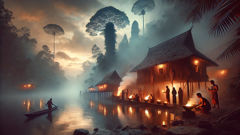Introduction
The rainforest breathes in slow, green rhythms around the longhouses of the Iban, each breath a history, every mist a memory. Here, where the Rajang and other rivers cut veins across the land, the world is stitched together by stories and names spoken at dusk: names of gods, of river-souls, of thunderbirds and ancestral lights. The Iban do not speak of the heavens as separate from the longhouse, the field, or the hunter's path; they name a web of powers—Petara—that govern weather and war, luck and harvest, the crossing from life to the ancestors. This retelling walks that web, honoring the cadence of oral tradition and the careful markers of ritual. I write with respect for the living communities for whom these stories remain meaningful; with curiosity for the ways myth organizes relationships between humans and landscapes; and with imagination where the oral record is private or imperfectly known. You will meet Sengalang Burong, the thunder-bringing bird whose cry directs warriors and signals fate; river spirits who carry messages between the dead and the living; guardian deities who watch over gardens, rice, and the forging of steel; and lesser Petara with crooked wisdom that teaches humility. Alongside each portrait are rituals—pig offerings, music from the sape, the careful speech of the tuai rumah—that keep the lines open between world and nether. If you listen, the forest itself will seem to lean in, listening too.
Origins: How the Petara Shaped Rivers, Sky, and Longhouse
Long before the eye told time by clocks, the Iban spoke of origins as living maps. The first people were not so much born as called into being by a chorus of Petara that settled upon hill and water. In the oldest accounts passed down through tuai rumah and bards, the sky and the river were related like two kin who could not agree. The early Petara were beings of function—makers and givers: one named for rain, one for the bread-fruit, one for the flame that forges. My telling aligns with those older cadences: creation is not a single flash but a conversation extended in seasons.

On a night when the moon slid low, the thunderbird Sengalang Burong thundered into being. Where its wings beat, mountains trembled and rivers received new channels. Sengalang Burong's voice split the sky; its cry brought lightning as the instrument of choice that taught men to honor the timing of war and the forecast of fortune. The thunderbird is not merely violent: it is boundary-keeper. In tales, Sengalang Burong perched on a tall tree and watched the first canoe carve a furrow. When the canoe drew close to an island of quick grass, Sengalang Burong flapped, and rain blessed the island's soil, so the first gardens could grow sweet yams and rice. From these acts came a code: when the thunder bird sings, one reads omen; when it is silent, one listens for other voices.
Other Petara arose like answering echoes. A river-deity—often imagined in the hushed tones of river-voices—took responsibility for movement between worlds. It would receive offerings cast into currents and, in return, ferry messages to those beyond sight. The river-deity was both mother and gate: it birthed fish and kept disease from the village when treated with ritual respect. The people learned to carve names into paddles and to sing to water at dawn, a small singing that mattered because speech opened doors.
Not all Petara were grand or loud. Beside the kitchen-fire sat minor household deities, guardians of the mortar, the rice-basket, and the hearth. They taught rules of taste and courtesy, not through laws but through stories of mischief: a sacred mortar left uncared for might steal the taste from future rice; an unhonored rice-basket would make broth boil over in anger. Such cautionary tales served as moral primers: respect is enacted, and the gods reward or chide in everyday details. These intimate Petara preserved the social threads that keep a longhouse together—the duty to share meat, the obligation to greet passersby, the humility to yield a place on the communal platform.
Rituals established the grammar of the relationship between people and Petara. Sacrifice is not mere exchange; it is conversation by smoke, sound, and the careful placement of things. A pig offered at the head of the longhouse is more than meat: it is a promise that the longhouse will remain under the watch of its god. The tuai rumah—longhouse head—plays an essential role, functioning as intermediary and storyteller. The tuai rumah's recitations name Petara into presence, retell ancient debts, and reset the balance when misfortune arrives. In some tales, when the longhouse is sick with misluck, only a specific sequence of songs, a particular drumbeat answered by a call on the sape lute, and the correct offering to the river-deity can restore favor. The ritual is technical and lovingly precise: it is a technology of belonging.
Origin stories also teach humility about power. The Petara, while mighty, are sometimes portrayed with quirky foibles—a sky-god who misplaces a cloud, a river spirit fond of a certain kind of woven cloth—reminders that even gods are woven into social life and subject to the same patterns of reciprocity. These stories sustain the ethic that power must be bound by duty and that privilege without stewardship invites fall. They hold up models for human leaders: to be a tuai rumah is to be petara's human mirror, a keeper of lines and a reader of signs.
The forest itself is more than backdrop; it is an active conscience in origin narratives. Trees speak in creaks that elders interpret as counsel. Sometimes the forest will hide a dangerous fruit until a child learns to ask permission; sometimes it will offer a rare herb to a healer who honors the grandmother of the valley. In these tales, Petara are intimately naturalistic—neither solely transcendent nor reducibly local; they are dynamic inhabitants of the same landscape humans inhabit. That relational depth is the oldest lesson: the land and the people exchange care, and myths encode that contract with beauty and law.
Through the long centuries, the origin stories stayed alive because they were told in the practical language of work—how to plant, when to hunt, which season to avoid storms—and in songs that children learn between chores. The moral scaffolding of the beginning is simple: name your world carefully, meet your promises, and listen for the cry of the thunderbird and for messages carried in river-splash. For the Iban, to remember origins is to remember how to live well in place, an ethic that both grounds identity and guides action.
Portraits and Rituals: Sengalang Burong, River Spirits, and the Many Petara
To know the Petara is to learn a gallery of portraits—each portrait a condensation of role, tale, and ritual. In the longhouse, these portraits were not painted upon walls but carved into speech, music, and repeated gesture. Below are careful renderings of some principal Petara, assembled from oral motifs and the texture of ritual practice, offered with respect for the living knowledge-keepers of Iban communities.

Sengalang Burong: The Thunderbird
Sengalang Burong is the most dramatic of the Petara in many stories. Its cry sounds like a trumpet and speaks of fate: when it is heard before a journey or a raid, hunters and warriors parse whether the bird's call heralds blessing or admonition. Sengalang Burong is both an omen and enforcer, keeper of war's ethics. Tales tell of a chief who neglected to ask the thunderbird's approval before leading men into conflict; lightning fell as if to remind him of the cosmic ledger. Yet Sengalang Burong also blesses: when a village honors a fallen family with the correct sacrificial sequence—pig, song, the cutting of a specific bamboo—the bird descends to accept the offering and, in exchange, lifts a cloud of mist that hides the village from malice for a season. Rituals for Sengalang Burong involve specific drum patterns and the presentation of feathered objects; these acts are both petition and recognition that power must be named.
The River Petara: Ferrymen of the Living and Dead
River spirits maintain the thresholds between the living world and the ancestral realm. In story after story, the river is a hairline path where messages are ferried in the form of offerings: betel nut, woven cloth, and sometimes small tokens that represent a lost person's favorite object. The river is practical in its demands: it requires offerings right at the riverbank, thrown with certain words. If offerings are made poorly, the river will not carry messages and might instead carry illness; if offerings are precise, the river will ferry the dead to the appropriate ancestor or return a favor as an unexpected bounty of fish. Midwives and grave-singers consult the river's temperament before certain rituals. Legends underscore a principle: crossing must be negotiated through correct forms, and the river's obedience depends on human attentiveness.
Petara of the Garden and Forge
Plant life is watched by petara who reward careful cultivation. There is a deity of the hill-field who ensures yams swell fat when farmers practice the time-honored sequence of fallow and planting. Another petara oversees metal and flame: the blacksmith's god who teaches the right timing for hammer stroke and the right song to sing while forging. These gods are intimately practical—if you forget the song or overheat the ore, the object will be flawed and misfortune may follow. The smith's god is, in one popular tale, jealous of artless pride: he blessed a crafty blade to find its maker humbled by the weight of his own weapon. Governance of craft by Petara reinforces humility and respect for skill.
Ancestor-Petara and the Networks of Memory
Ancestors occupy a liminal place: neither fully belonging to the present nor completely gone. Their spirits are Petara in the sense that they enforce and bless according to the family line. An ancestor might intervene in dream or omen to warn of theft or to encourage a new marriage. Clan narratives insist on the maintenance of altars and naming patterns precisely because the ancestors’ presence moderates immediate choices: naming a child after an ancestor keeps continuity and calls their guidance into the child's life. Such practices maintain social memory and ethical continuity.
Lesser Petara and the Humor of Small Gods
Not all deities are towering, solemn figures. Some are mischief-makers who teach through embarrassment. A tale tells of a small river-sprite who would untie the sandals of boastful men walking home from market; the sprite taught modesty by making them appear foolish at the communal doorway. These pocket-sized deities enforce norms through trickery rather than thunder, a cultural mechanism that diffuses tension: scolding without blood.
Ritual Practice: Offerings, Songs, and the Work of Naming
Ritual is the grammar that makes portraiture operative. Offerings range from small tokens—woven cloth, betel nut—to larger sacrifices like a mid-sized pig for community ceremonies. Songs and recitative are essential; they are not ornamental but operative acts that call Petara into presence. The sape lute and drum rhythms are part of the language: different songs accompany river petitions, harvest thanks, or war-sending. Speech itself is carefully calibrated: certain names are uttered only during ritual sequences; certain gestures—an offering placed fingertips-first—signal submission.
The Role of the Tuai Rumah and Biku
Intermediaries are central. The tuai rumah administers household-level rites, while the biku (a shamanic figure in some accounts) negotiates with more volatile spirits. The biku prescribes the correct offerings and interprets omens. Their expertise is technical, inherited, and socially sanctioned. In times of epidemic, the biku's dance and smoke, accompanied by specific chants, are what the community turns to; in times of drought, the tuai rumah organizes collective offerings to spring deities. These roles are not mere superstition; they are social devices that coordinate community action when environmental uncertainty threatens subsistence.
Adaptation and Continuity
Through contact and change, Iban belief has adapted, incorporating new names and recontextualizing old ones. Yet the basic cosmology remains: humans live in reciprocity with Petara, and that reciprocity is enacted through ritual, story, and daily attention. The portraits above are not exhaustive but serve as gates into a living imagination where gods speak with the cadence of rain and the sharpness of a newly forged blade. To know any of them well is to learn what the Iban know about how to live with power—how to ask, how to pay attention, how to return.
Conclusion
Across generations, the Petara remain a living conversation between people and place. The tales that name thunderbirds, river guardians, smith's companions, and household sprites do more than explain natural events; they teach an ethic of reciprocity, humility, and attention. Rituals—from the simplest offering thrown into the river to the complex sequence that restores a longhouse's balance—are technologies of relationship, ways of being that anchor community in time. As the Iban move through the modern world, these stories continue to adapt: they provide vocabulary for environmental stewardship, models for leadership, and a sense that the land and its spirits are not resources to be plundered but kin to be negotiated with care. If you listen to the river at dawn or watch a thunderbird's silhouette against the sky, you participate in an age-old practice: you name the world and, in naming, make a promise to it. That promise—small, practical, and repeated—keeps the longhouse and the forest in conversation.













